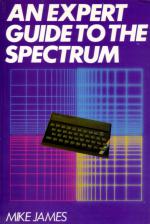
ZX Computing
 1st October 1984
1st October 1984
Published in ZX Computing #15
An Expert Guide To The Spectrum
If your bookshelves are already almost full of "Instructions To...", "Beginners Course In..." and other elementary texts for better Spectrum use, then I suggest that you may well find an Expert Guide To The Spectrum by Mike James a worthwhile addition to make. Of course, books for Spectrum users at all levels proliferate and there is nothing new in books for more advanced reading, but maybe it's because this one says what the best part of most of them do that I found it such a good read.
Mike James is the author of several very successful books on programming, and many more to come I'm sure. Why am I being quite so generous with the praise? My temperature feels alright. I don't think I need a holiday. I must confess I would be getting worried if it wasn't for the blatant fact that Mr. James is a very good writer and deserves any praise - at least for this book, let's not carried away - that I might lavish.
He doesn't mess around prattling on about this, that and the other before finally making a stab at the topic in question. I get the feeling that he now knows his subject so well that he didn't need to use any notes. His familiarity with the subject shows. As a result, the text doesn't labour; moving quickly from point to point while at the same time being aware of the reader and possible areas of difficulty. The text is concise; but accurate and clear and a stimulating read.
1-8 million Spectrum users can't be wrong (figures approx, correct at time of writing i.e. 6.45pm), the Spectrum is a remarkable machine and, as such, enables programmers to do remarkable things with it. Logically, an investigation of these remarkable features will enable programmers to put them to good use. The reader is required to have no more than a working knowledge of basic to undertake this investigation.
Chapter one, an overview of computer hardware in general, examines busses, addresses, data and bit patterns and effectively establishes the fundamental relationship that exists between them - Ah! So that's why the highest address is 65535! Chapter two is more specific to the Spectrum, the intention being that a knowledge of the hardware will influence the reader's approach to software, and to this end the memory, the video display, input and output devices and the ULA are discussed. Much of the material of the first two chapters is used and devoted further in later chapters dealing with more specific topics.
As important as the hardware, the software: the ZX Basic is looked at in chapters 3, 4 and 5. In all there are twelve chapters covering the above, the video display, video applications, tape, sound and printer, interface and microdrives, communications and advanced programming applications.
Readers may well have to turn back a few pages sometimes; indeed, the author recommends that the reader should read from front to back and then from back to front. That can only be because of the complexity of the subject and not its treatment on the pages. And, even if subsequent readings are necessary then that should require little effort for this is one of the most valuable books I have read this year.
Scores
Spectrum 48K Version| Overall | 91% |


